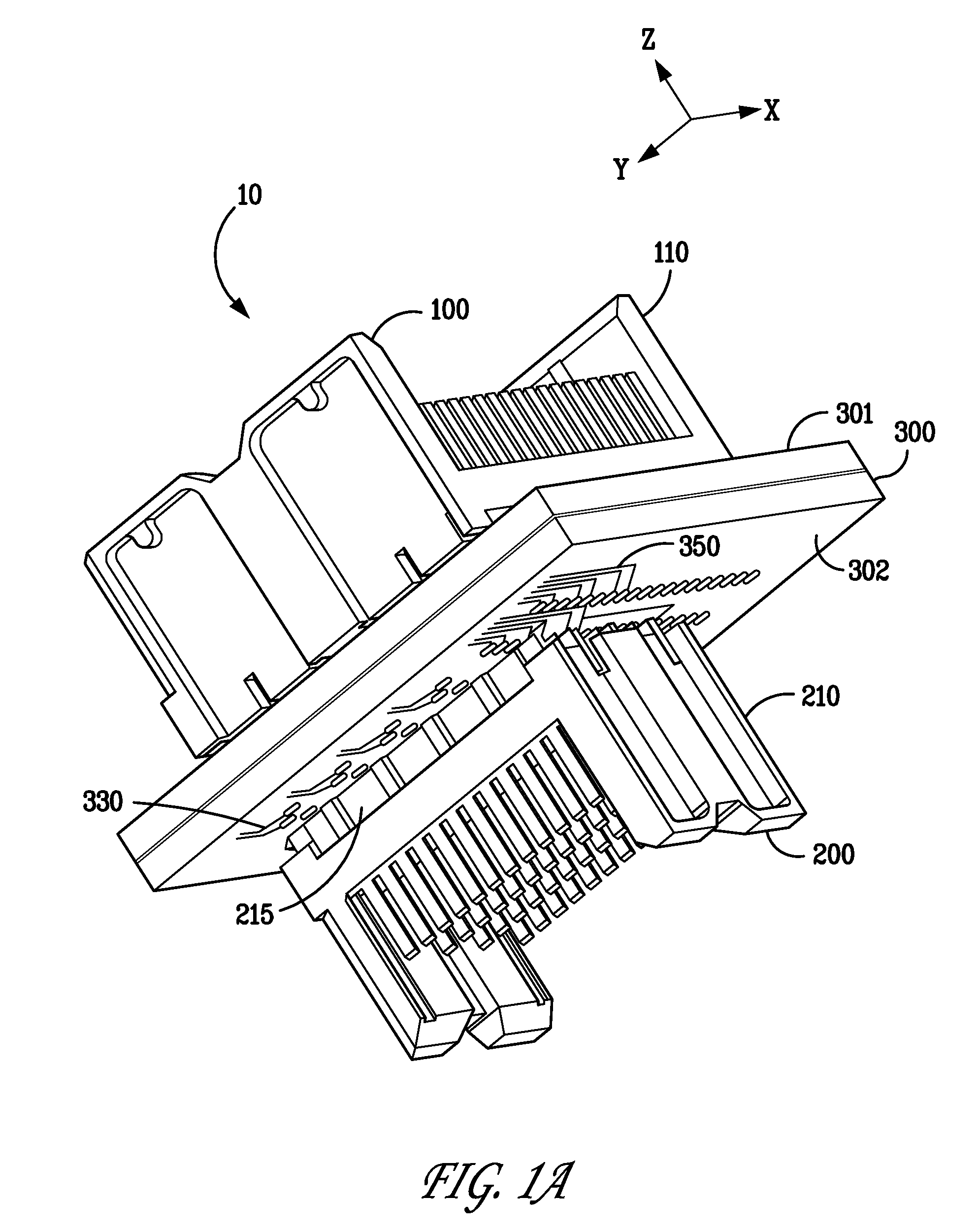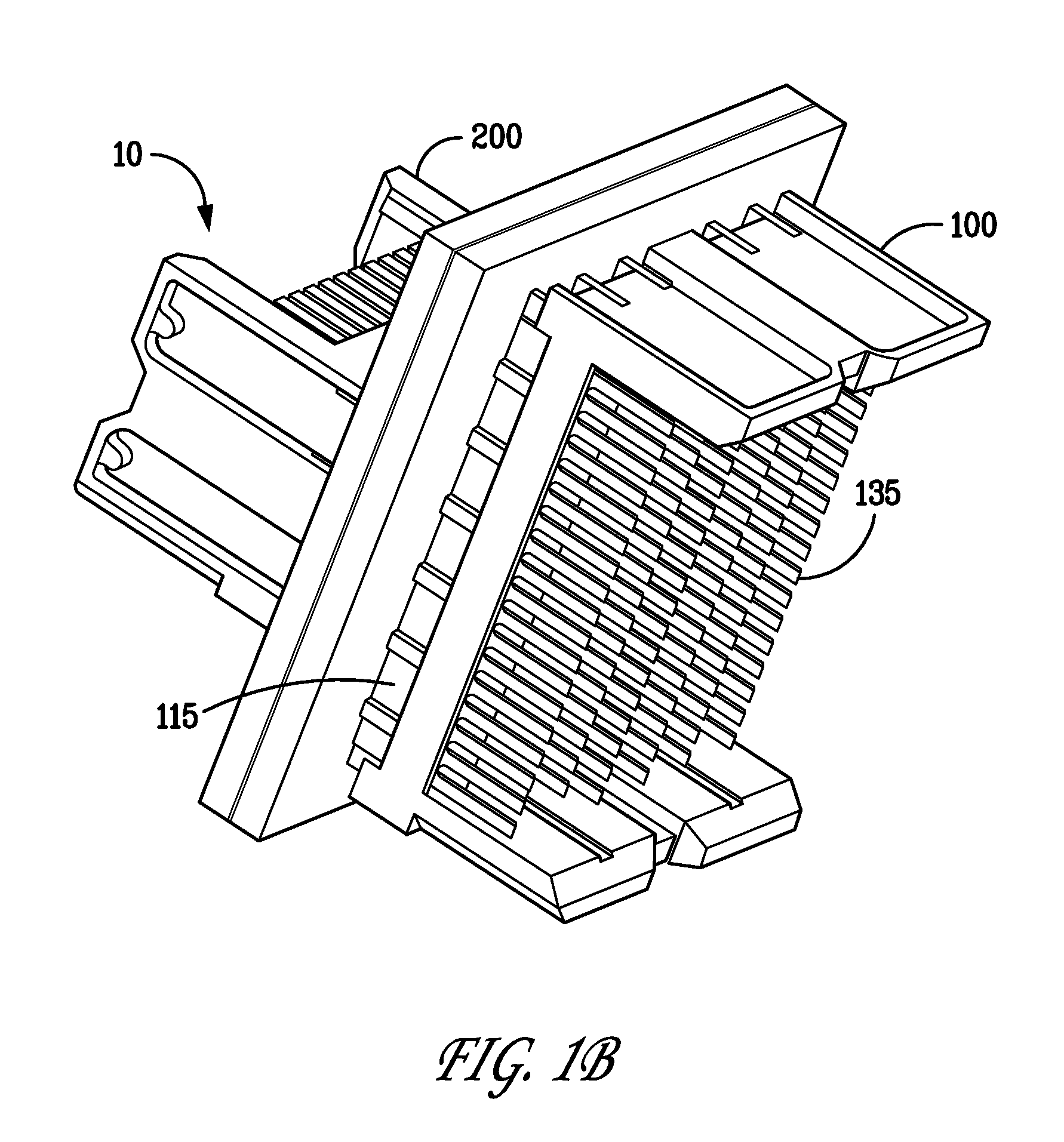Electrical connector system with orthogonal contact tails
a technology of connectors and tails, applied in the direction of fixed connections, coupling device connections, coupling protective earth/shielding arrangements, etc., can solve the problems of limiting the available channels for trace routing on the midplane pcb, limiting the spacing between, and not allowing electrical connection of connector contacts. , to achieve the effect of convenient routing
- Summary
- Abstract
- Description
- Claims
- Application Information
AI Technical Summary
Benefits of technology
Problems solved by technology
Method used
Image
Examples
second embodiment
[0083]FIG. 10 depicts a pin-out diagram of the midplane for the mounted connector pair, wherein a 4×4 orthogonal connector is electrically connected to a 6×6 mixed connector. FIG. 10, which is shown from the view of first side 301 of midplane 300, shows the details of the electrical mating between the orthogonal columns of contact tails 120a, 120b, 120c, and 120d of mixed leadframe connector 100 and the orthogonal columns of contact tails 220a, 220b, 220c, and 220d of orthogonal leadframe connector 200. FIG. 10 shows sixteen (16) pairs of signal contact tails 123 from mixed leadframe connector 100 mated with the corresponding sixteen pairs of signal contact tails 223 from orthogonal leadframe connector 200. Also shown in FIG. 10 are two standard columns of contact tails 140a and 140b of mixed leadframe connector 100, which, in this embodiment, are not electrically connected to corresponding contact tails of orthogonal leadframe connector 200.
[0084]This second embodiment, electrical ...
first embodiment
[0085]In FIG. 10, the two standard columns of contact tails 140 within leadframe housing 110 are at opposite ends of leadframe housing 110, with the four orthogonal columns of contact tails 120 between the two standard columns of contact tails 140. Accordingly, the two standard columns of vias 340 in midplane 300 are at opposite ends of midplane 300, with the orthogonal pattern of vias 320 positioned in between the two standard columns of vias 340. As in the first embodiment electrical connector system 10, orthogonal leadframe connector 200 mates with mixed leadframe connector 100 through shared vias in midplane 300, but in electrical connector system 20, orthogonal leadframe connector 200 is approximately centered in the X-Y plane (as shown by the arrows designated X and Y in FIG. 1A) relative to mixed leadframe connector 100, wherein the sixteen (16) pairs of signal contact tails 223 in connector 200 mate with the 16 pairs of signal contact tails 123 in the center of mixed leadfra...
third embodiment
[0096]FIG. 11B depicts a pin-out diagram of the midplane for the third embodiment depicted in FIG. 11A. FIG. 11B, which is shown from the view of first side 301 of midplane 300, shows the details of the electrical mating between the orthogonal columns of contact tails 120a, 120b, 120c, and 120d of orthogonal leadframe connector 100′ and the orthogonal columns of contact tails 220a, 220b, 220c, and 220d of orthogonal leadframe connector 200. FIG. 11B shows sixteen (16) pairs of signal contact tails 123 from mixed leadframe connector 100′ mated with the corresponding sixteen pairs of signal contact tails 223 from orthogonal leadframe connector 200. Also shown in FIG. 11B are two additional orthogonal columns of contact tails 120e and 120f of orthogonal leadframe connector 100′, which, in this embodiment, are not electrically connected to corresponding contact tails of orthogonal leadframe connector 200.
[0097]Comparing FIGS. 9 and 11B, the difference between the first embodiment (elect...
PUM
| Property | Measurement | Unit |
|---|---|---|
| metallic | aaaaa | aaaaa |
| dielectric | aaaaa | aaaaa |
| electrically conductive | aaaaa | aaaaa |
Abstract
Description
Claims
Application Information
 Login to View More
Login to View More - R&D
- Intellectual Property
- Life Sciences
- Materials
- Tech Scout
- Unparalleled Data Quality
- Higher Quality Content
- 60% Fewer Hallucinations
Browse by: Latest US Patents, China's latest patents, Technical Efficacy Thesaurus, Application Domain, Technology Topic, Popular Technical Reports.
© 2025 PatSnap. All rights reserved.Legal|Privacy policy|Modern Slavery Act Transparency Statement|Sitemap|About US| Contact US: help@patsnap.com



